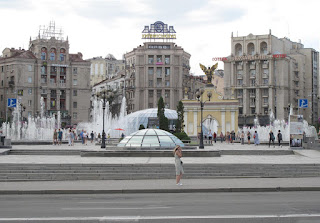The first tour in Kiev took us past some prominent buildings, such as the Government Building where the hammer and sickle emblem above the front entrance was removed after the fall of communism in the 1980s.
This area of town also hosts the Princess Olga Monument that was demolished in 1920 but restored again in 1996. No doubt, this monument was demolished because Olga was declared a saint for her efforts to spread Christianity in the region -- and the communists would not have been impressed, to say the least.
When walking our way to St Andrew's Cathedral, our guide pointed to a beige-colored apartment complex that was occupied by communist officials during their reign. It was selected, she said, because this area of town has a high elevation and the officials would have a vantage point overlooking the city.
The After Two Hares Characters Monument, based on characters in a Ukrainian movie, was erected in front of this building in the late 1990s.
There were many vendors in front of St Andrews and it's obvious this area remains a social magnet for the locals. I was able to sneak a picture of men playing a game brought to the region by the Cossacks.
The cathedrals in Kiev show signs of varied architectural influence including the many spires and domes protruding into the city skyline. One example is the Sophia Cathedral near the Hetman Bohdan Khmelnitsky monument, located almost in the middle of the Sophia Square. This monument is a tribute to the man who led an uprising against the Commonwealth and its magnates (1648–1654) that resulted in the creation of a state led by the Cossacks of Ukraine.
A website devoted to Kiev describes the city's architecture as...
"...an extraordinary phenomenon. The unique and extremely diverse cityscape has been transforming for 14 centuries. Thus, the buildings and streets of the Ukrainian capital combine more than 30 different architectural styles, which accurately reflect the stages of the city’s formation. Kiev is called the city of domes for a reason. The Ukrainian capital boasts around 950 churches and cathedrals, which were under construction from the Kievan Rus era up to today. For instance, Saint Michael’s Golden-Domed Monastery and Saint Sophia’s Cathedral were built at the beginning of the 11th century." (theculturetrip.com, 2018)
On the second day, our guide took us to what is known as the preeminent Eastern Orthodox Christian Monastery, a complex of streets and buildings called Kiev Pechersk Lavra. This monastery had its beginnings when a monk in the early 11th century came to Kiev as a missionary and chose to reside in a cave. An ever-expanding network of buildings developed over time to house roughly 1200 monks before the 1917 Revolution. Since there was no building of churches or focusing on religion during the 70 year Soviet reign, it is no surprise that only 100 monks reside in this monastery today as religion slowly regains a foothold in the country.
The Cathedral of the Dormition is at the heart of the monastery complex, located in the same central square as the Great Lavra Belltower. This cathedral holds services to celebrate over 300 saints annually, which means a service is held most every day in honor of a designated saint. Our group was privileged to observe a ceremony in this cathedral and its high order orthodox proceedings.
Quite a few orthodox pilgrims participated in the service even though they were not in the cathedral itself, but scattered throughout the surrounding courtyard.
The Belltower stands at 90.5 m (over 200 steps) high and is open to visitors willing to make the trek to the top.
With permission, I was able to get a few photos inside the Refectory Church, the third in a series of temples in the center of the complex.
Without question, the most unique part of our visit to the monastery was walking through the underground catacombs. Known as the Kiev Pechersk Lavra caverns, it comprises of a complex system of narrow underground corridors along with numerous living quarters and underground chapels. Worshipers pay homage to over 100 saints buried here.
We lit candles and walked through the corridors, observing numerous covered bodies in open coffins along with accompanying relics. This site is deemed sacred by many orthodox Christians so, obviously, no pictures were allowed and we had to dress conservatively. I found a few pictures off the internet that can relay our experience.
It was a long climb up to the front gate of the monastery where our bus was waiting to take us back to the ship. The walk was worth it, though, because it provided added opportunity to observe the lower part of the monastery.
Besides attending formal tour groups, my relatives and I ventured into Kiev for some impromptu explorations. An amusement park together with beautiful green areas, suitable for pedestrian traffic, awaited us along the waterfront as we debarked the Dnieper Princess.
My walking partners Louise, John, Jonathan and Becky
Walking the streets of Kiev allowed us to experience everyday street life and test our sense of direction!
There was no trouble relaxing onboard after a long day's journey through the city. How great to sit back and enjoy the cityscape over good conversation while the ship remained docked in port.




























